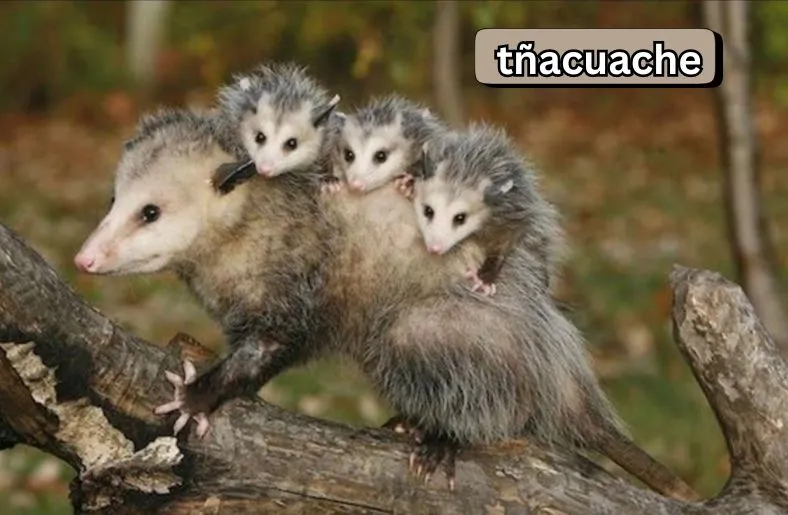Introduction
The tñacuache, also known as the opossum, is a fascinating animal. It is a marsupial, meaning it carries its babies in a pouch. This unique feature makes it different from many other mammals. The tñacuache is often found in various habitats, from forests to urban areas. Its ability to adapt to different environments helps it thrive.
Many people are curious about the tñacuache. They wonder about its habits, diet, and behavior. Understanding this creature can help us appreciate its role in nature. As scavengers, tñacuaches clean up waste and control insect populations. This makes them important for keeping ecosystems healthy.
In this article, we will explore the world of the tñacuache. We will look at its physical traits, habitat, diet, and more. By learning about this remarkable animal, we can gain a deeper understanding of wildlife and the environment around us.
What is a Tñacuache?
The tñacuache, or opossum, is a unique marsupial native to the Americas. Unlike many mammals, tñacuaches carry their young in a pouch. This pouch protects and nourishes the tiny babies as they grow. The scientific name for the tñacuache is Didelphis virginiana. They are known for their adaptability, thriving in various environments.
Tñacuaches can be found in forests, grasslands, and even cities. This adaptability allows them to survive in different climates. They are medium-sized animals, usually measuring 30 to 50 centimeters long. Their prehensile tail adds another 25 to 40 centimeters, helping them climb and balance. With gray to white fur, tñacuaches have a distinct mottled appearance. Their large ears and long snouts make them easily recognizable.
Additionally, tñacuaches play a vital role in the ecosystem. As omnivores, they eat fruits, insects, and small animals. This varied diet helps control pest populations and disperse seeds. By doing this, they contribute to a healthier environment. Overall, the tñacuache is a fascinating animal with many unique characteristics and an essential ecological role.
Physical Characteristics
The tñacuache is a medium-sized marsupial with several notable features. Typically, it measures between 30 to 50 centimeters in body length. Its prehensile tail can add another 25 to 40 centimeters. This tail helps the tñacuache climb trees and balance while foraging for food.
The fur of a tñacuache is coarse and varies in color. Most have a mottled appearance, ranging from gray to white. This coloration helps them blend into their surroundings, providing camouflage from predators. Additionally, they have large ears and a long snout, which enhances their hearing and sense of smell.
Their sharp teeth are well-suited for an omnivorous diet, allowing them to eat fruits, insects, and small animals. Tñacuaches have strong, agile hands and feet equipped with sharp claws. These features aid them in climbing and digging, making them skilled foragers.
Overall, the physical characteristics of the tñacuache make it a remarkable creature. Its unique adaptations enable it to thrive in diverse environments, from urban areas to forests. Understanding these traits helps us appreciate this fascinating animal even more.
Habitat and Distribution
The tñacuache is a highly adaptable animal found in many regions. It lives in North, Central, and South America, from Canada to Argentina. This wide range shows how well it can adjust to different environments. Tñacuaches thrive in various habitats, including forests, grasslands, and urban areas. They often choose places with plenty of food and shelter.
In forests, they find many trees to climb and explore. Grasslands offer open spaces for foraging and finding food. In cities, tñacuaches adapt by rummaging through garbage and exploring gardens. Their ability to live in both wild and urban settings is impressive.
Tñacuaches are also adaptable to different climates. They can survive in both hot and cold temperatures. In warmer areas, they use shade to stay cool. When it gets cold, they grow thicker fur and store body fat. This adaptability helps them thrive wherever they go.
Understanding the habitat and distribution of the tñacuache highlights its resilience. These creatures can find a home in many environments, showing how nature’s diversity supports life. By learning about where they live, we can better appreciate their role in our ecosystems.
Diet and Feeding Habits
The tñacuache is an omnivore, meaning it eats both plants and animals. Its varied diet helps it survive in different environments. Tñacuaches enjoy fruits, insects, and small animals. They also eat carrion, which is a dead animal. This wide range of food sources makes them adaptable and resourceful.
Tñacuaches are opportunistic feeders. They often scavenge for food, using their strong sense of smell to locate meals. When searching for food, they explore their surroundings with curiosity. Their sharp claws help them dig through the ground or tear open fruit. This ability to find various food items ensures they stay well-fed.
In urban areas, tñacuaches adapt their feeding habits. They are often seen rummaging through garbage cans for leftovers. This scavenging behavior allows them to thrive in human-inhabited areas. Their ability to adjust their diet helps them find food, even in challenging conditions.
The tñacuache plays an important role in its ecosystem. By eating insects and small animals, it helps control their populations. Additionally, when tñacuaches eat fruits and then disperse the seeds in their droppings, they support plant growth. This natural process benefits the environment and shows how tñacuaches contribute to the balance of nature.
Behavior and Social Structure
Tñacuaches are mainly nocturnal, meaning they are active at night. During the day, they rest in dens or hidden spots. This behavior helps them avoid predators and stay safe. At night, they come out to explore and search for food. Their nighttime activity allows them to find meals while avoiding danger.
In terms of social structure, tñacuaches are generally solitary animals. They do not form large groups like some other species. Instead, they prefer to live alone, coming together only for mating. This independence helps them avoid competition for food and territory. It also reduces the chances of conflicts with other tñacuaches.
When communicating, tñacuaches use various sounds. They hiss, growl, or screech to express themselves. These vocalizations can signal fear, aggression, or excitement. Additionally, tñacuaches use body language to communicate. They may arch their backs or bare their teeth to show feelings.
Despite being solitary, tñacuaches have a unique way of defending themselves. When threatened, they often play dead. This behavior, called thanatosis, confuses predators and can help them escape danger. By staying still and appearing lifeless, tñacuaches can avoid being eaten. This clever strategy showcases their adaptability and survival skills.
Reproduction and Life Cycle
Tñacuaches have a unique reproductive cycle that varies by location. Generally, they breed once or twice a year. The breeding season usually depends on the climate and available resources. After mating, the female tñacuache experiences a short gestation period of about 12 to 14 days. This quick gestation allows her to have babies sooner.
Once the young are born, they are tiny and undeveloped. They immediately crawl into their mother’s pouch. Inside the pouch, the babies continue to grow and develop. They stay there for about two months, feeding on their mother’s milk. As they grow, the mother provides a safe environment until they are strong enough to explore the world.
After leaving the pouch, the young tñacuaches ride on their mother’s back. This way, they can learn about their surroundings. They stay with their mother for a few weeks before becoming independent. In the wild, tñacuaches typically live for around 2 to 4 years. Their short lifespan is often due to predators and environmental challenges. Understanding their life cycle helps us appreciate the resilience of these fascinating creatures.
Ecological Impact
Tñacuaches play an important role in their ecosystems. First, they help control insect populations by eating various bugs. This keeps the insect numbers in check and supports a balanced environment. Their presence can reduce the chances of insect outbreaks that might harm plants and crops.
Additionally, tñacuaches are scavengers. They consume dead animals and organic waste, helping to clean up the environment. By eating carrion, they prevent the spread of disease. This makes them beneficial for both wildlife and human areas.
Moreover, tñacuaches assist in seed dispersal. As they eat fruits, they help spread seeds through their droppings. This supports plant growth and diversity in their habitats. Overall, tñacuaches contribute significantly to the health of their ecosystems. Understanding their ecological impact helps us value their role in nature.
Conservation Status
The tñacuache is currently not endangered. However, they face several challenges in their habitats. Habitat destruction, mainly due to urban development, threatens their living spaces. As cities expand, tñacuaches lose their homes and food sources. This can lead to population declines in some areas.
Road accidents are another significant threat. Many tñacuaches get hit by vehicles while crossing roads. This risk increases as they roam in search of food. Raising awareness about their presence can help reduce these accidents.
Conservation efforts are important for their future. Protecting natural habitats can ensure that tñacuaches thrive. Supporting wildlife organizations and community education programs can make a difference. By promoting a better understanding of tñacuaches, we can help protect these unique animals. Overall, taking action now will benefit both tñacuaches and our environment.
Cultural Significance
The tñacuache holds a special place in many cultures. In folklore, it often symbolizes adaptability and survival. Stories about this animal teach lessons about resilience. For example, tales may highlight how the tñacuache cleverly avoids danger. These stories help people appreciate the creature’s unique traits.
Additionally, the tñacuache appears in art and literature. It inspires artists with its interesting features and behaviors. Children’s books sometimes feature tñacuaches as friendly characters. These representations encourage curiosity and compassion for wildlife. Overall, the tñacuache enriches cultural narratives, reminding us of nature’s importance.
Conclusion
In conclusion, the tñacuache is a remarkable creature with unique traits and vital ecological roles. From its adaptability in various habitats to its importance in controlling pests and dispersing seeds, this marsupial enriches our environment. Understanding the tñacuache helps us appreciate wildlife and the delicate balance of ecosystems. Furthermore, its cultural significance highlights the lessons we can learn from nature. As we work to protect their habitats and raise awareness about their needs, we ensure a brighter future for tñacuaches and the health of our planet.





